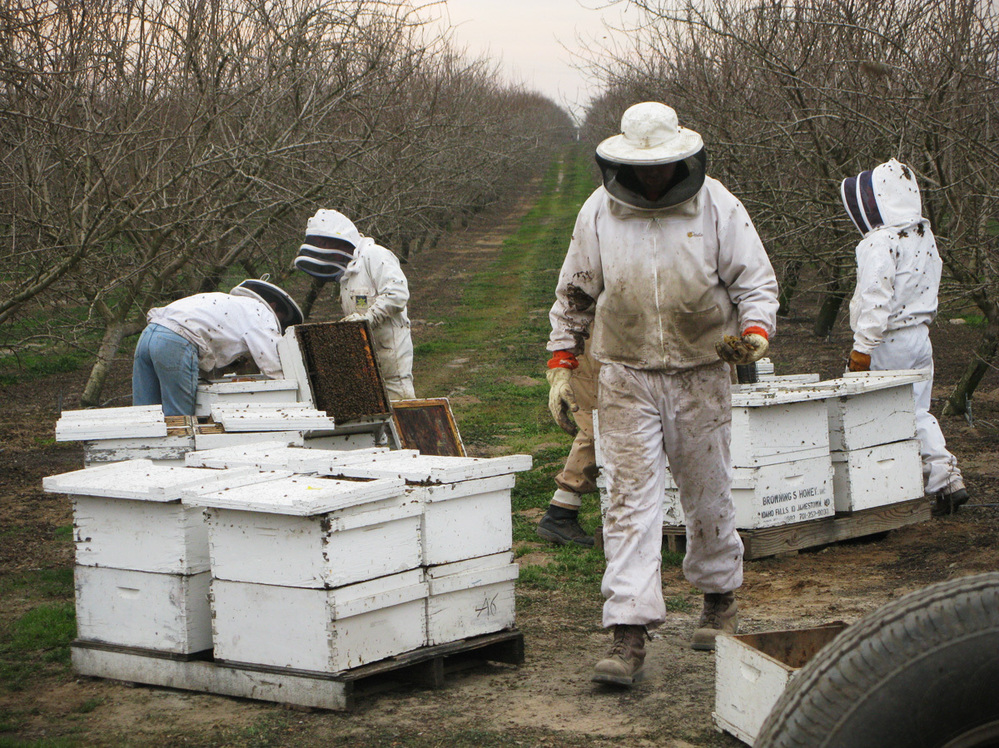 Enlarge image i
Enlarge image i Wild bees, such as this Andrena bee visiting highbush blueberry flowers, play a key role in boosting crop yields.

Wild bees, such as this Andrena bee visiting highbush blueberry flowers, play a key role in boosting crop yields.
Some of the most healthful foods you can think of blueberries, cranberries, apples, almonds and squash would never get to your plate without the help of insects. No insects, no pollination. No pollination, no fruit.
Farmers who grow these crops often rely on honeybees to do the job. But scientists are now reporting that honeybees, while convenient, are not necessarily the best pollinators.
A huge collaboration of bee researchers, from more than a dozen countries, looked at how pollination happens in dozens of different crops, including strawberries, coffee, buckwheat, cherries and watermelons. As they report in the journal Science, even when beekeepers installed plenty of hives in a field, yields usually got a boost when wild, native insects, such as bumblebees or carpenter bees, also showed up.
"The surprising message in all of this is that honeybees cannot carry the load. Honeybees need help from their cousins and relatives, the other wild bees," says Marla Spivak, a professor of entomology at the University of Minnesota. "So let's do something to promote it, so that we can keep honeybees healthy and our wild bee populations healthy."
Unfortunately, a second study, also released in Science this week, makes it clear that wild bees aren't having an easy time of it.
That study essentially follows in the century-old footsteps of Charles Robertson, "one of America's great scientists that nobody knows about," says Laura Burkle, an ecologist at Montana State University.
Robertson taught biology and Greek at Blackburn College in Carlinville, Ill., and he was fascinated by the close connection between insects and flowers. He spent years in the forests around Carlinville, carefully noting which insects visited which wild flowers at what time of year.
Burkle and Tiffany Knight, a colleague at Washington University in St. Louis, went back to Carlinville to see how much of the ecosystem that Robertson observed still exists today.
Much of the forested area around the town has been converted into fields of corn and soybeans or suburbs. In the fragments of forest that remain, Burkle and Knight found all of the flowering plants that Robertson recorded in his notes a century ago. Of the 109 species of bees that Robertson saw, though, just over half seemed to have disappeared from that area.
"We don't know why," says Burkle.
One possibility might be a loss of nesting sites for these bees. But a changing climate may also play a role.
The bees that disappeared tended to be species that depended on just a few kinds of flowers for food. For those bees to survive, their preferred flowers have to be blooming when the bees start flying and need food. The warming trend might have thrown off that timing.
 Enlarge image i
Enlarge image i Hired beekeepers work to pollinate an almond orchard near Snelling, Calif. Wild bees play a critical role in helping honeybees pollinate crops, but they often can't survive on modern monoculture farms.

Hired beekeepers work to pollinate an almond orchard near Snelling, Calif. Wild bees play a critical role in helping honeybees pollinate crops, but they often can't survive on modern monoculture farms.
In fact, Burkle says, if you map the interactions between flowers and bees, they seem more tenuous now. Some flowers may get visited by just one or two kinds of bees, and maybe just for one week.
"I don't know that these systems can take a lot more environmental change without something drastic happening," she says.
Many bee researchers are trying to figure out how to help those native bees and how to help farmers who benefit from them.
Claire Kremen, a conservation biologist at the University of California, Berkeley, who's a co-author of the first study in Science, says one of the biggest problems for wild bees is the agricultural specialization that has produced huge fields of just one crop.
The almond groves of California, for example, are a sea of blossoms in February. It's a feast, as far as the eye can see, for honeybees that come here from all over the country.
"But for the rest of the year, there's nothing blooming," she says.
That means there are no bees. "In fact, in places where we have very large monocultures of almond, we don't find any native bees anymore," Kremen says.
Planting other flowers in and around these almond groves, maybe as hedgerows, blooming all summer long, would help, she says.
Even better would be farms with smaller fields, and lots of different crops flowering at different times. Wild bees, Kremen says, need diversity.
No comments:
Post a Comment